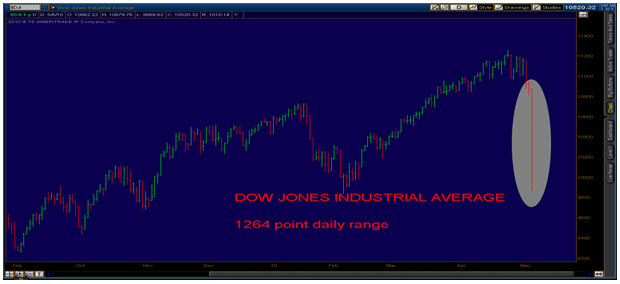U.S. Market Crashes Intraday
On Thursday, May 06, 2010, the U.S. market saw extreme volatility that may not have been seen since Black Monday in 1987. At about 2:45 EST the S&P 500 reached a low of 1065.79, this was 100 points lower than the open, or about – 8.6%. Within 20 minutes of this low point, buyers flooded the market and pushed the S&P up about 70 points, to close at 1128.15, down 37.72 points, or 3.24%. During the free fall, the Dow Jones lost the most points ever recorded intraday at about a 1000 point decline.The whole ordeal is still being investigated as the trading floor was filled with rumors that Procter & Gamble had an “erroneous trade” that brought the entire market down with it. Other rumors are that a faulty trade was placed in the S&P mini futures contracts to short 1 billion contracts instead of 1 million. Finally, others are saying that this was simply a computer issue.
What must be understood is that the market was already heading lower before the major fall, so the market sell of is not to be blamed solely on an error. A likely scenario is that computer based trading programs were searching for liquidity while traders were in panic and did not have any bids on a the security. At this point, human traders halted trading to wait for the market to discover a price, while computer based trades executed at whatever level it could find liquidity, which in some cases was a penny per share.
The ten year yield dropped to 3.4% as investors flocked to safe assets, oil ended the day at 76.9 per barrel, and gold rallied to 1200 as the EUR/USD pair continued to fall to 1.26. This will certainly be marked as a historical day in the US markets. The question now is if this is the beginning of a bear market, which would mean that the past year has simply been a strong bear market rally. With continued global debt issues, this scenario has become more believable to investors.
–A. Tarhini

The Emerging Markets Slump
The Asian stock market has slumped in the course of the European Debt crisis extending over Greece, with all the downgrades happening simultaneously. The TOPIX Index dropped by 3.3% while the Nikkei 225 has reached its lowest level down to 3.1% in the past two months. Also, we can see that the ASX 200 and KOSPI indices declined by 2.2% and 2% by Thursday.
Experts suggest that the growth in the emerging markets may be key to the decline of developed markets, due to the fact that, these boomers drive prices of commodities higher, which eventually impedes growth in the advanced nations. Due to an environment of low interest rates and relatively weaker market performances present, investors start shifting their funds to these emerging markets resulting in a higher growth and demand in these regions. Hence, a global imbalance of growth occurs, where the consumers in the emerging markets will be the driver of growth for the entire world, at the expense of the western consumers due to a slow rate of growth in these regions.
On the other side, as the chaos in Athens perturbs worldwide investors, Australian shares fell to 2.2% to a 3 month low by last Thursday, with increased fear of Greece’s debt crisis hitting banks in Europe. Thus, banks in Australia which dominate the market have been caught in the worldwide banking sector mess, which reduced the financial services index down by 3.3%.
Also, the S&P/ASX 200 Index that serves as the benchmark, saw a net change of -100.8 last Thursday, to finish at 4573.20, to the lowest level it has been since the mid of February, taking in almost a 5% loss during the course of the week .
Moreover, the weariness created by the new tax impositions to be laid on the mining sector has taken its toll, bashing the top miners in the continent. Even though the final tax structure has not been finalized, nor is there any certainty of it passing through the parliament; investors are now not willing to entertain any sort of risks of it going the way it is.
–Rowena Zacharia
Article submitted by: Alex Tarhini and Rowena Zacharia of the Capital Markets Lab (CML). To learn more about the Capital Markets Lab (CML) please visit https://business.fiu.edu/capital-markets-lab/..





